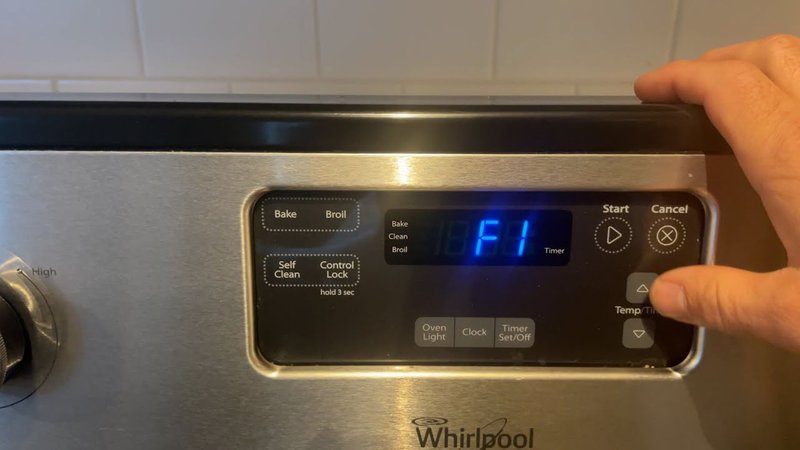
You might be wondering, “What in the world does Error Code F1 mean?” Think of it like your dishwasher’s way of saying, “Hey, something’s not quite right with the water heating process.” It’s essentially your dishwasher waving a little red flag. Often, it’s related to issues with temperature sensors, the heating element, or even the control board. But don’t fret! With a little guidance, you can understand what’s happening under the hood and how to potentially fix it.
Understanding the Error Code F1
When you see the F1 error on your Whirlpool dishwasher, it’s akin to a warning light in your car telling you that something needs attention. But rather than a complex mechanical issue, this is usually linked to the water heating component of your dishwasher. Imagine it as trying to make coffee without heating the water first—not quite effective, right? The dishwasher relies on heated water to sanitize and properly clean your dishes, and when this process falters, it lets you know via the F1 code.
The underlying cause can vary. Sometimes, it’s as simple as a malfunctioning heating element. This component heats the water to the necessary temperature for washing and sanitizing. If it fails, your dishwasher can’t do its job properly. Another possibility is the temperature sensor, which acts like a thermostat, detecting when the water reaches the right temperature. If it’s faulty, the dishwasher might not heat the water at all or might overheat it. Lastly, the control board, which is the brain of your appliance, might be sending incorrect signals due to a glitch or failure.
What’s the next step? Well, you’ll want to narrow down which part is causing the issue. It’s a bit like being a detective, but instead of solving a mystery in a novel, you’re doing it in your kitchen. By understanding these components and how they interact, you’re better equipped to find a solution.
Troubleshooting the Error
Now that we’ve got a handle on what could be causing the F1 error, let’s roll up our sleeves and tackle some troubleshooting steps. First things first, have you tried turning it off and on again? It might sound cliché, but resetting your dishwasher can sometimes clear minor glitches. Simply unplug the appliance for about a minute, then plug it back in and see if the error persists. It’s the digital age equivalent of taking a deep breath.
If that doesn’t do the trick, it might be time to check the heating element. This involves turning off power to the appliance (safety first!) and using a multimeter to check for continuity in the heating element. If the multimeter shows it’s not functioning, replacing it could resolve your F1 issue. It’s like swapping out a burnt-out bulb for a new one.
Should the heating element seem fine, the temperature sensor could be next on your checklist. It’s a bit like checking the thermostat in your home when the temperature feels off. Replacing a faulty sensor isn’t overly complicated, but if you’re not comfortable doing so, calling in an appliance repair technician might be the way to go.
Preventing Future Errors
No one wants to wrestle with appliance issues regularly, so let’s talk about keeping your dishwasher in tip-top shape. Think of it as giving your trusty old car a regular tune-up to prevent larger problems down the line. One handy tip is to avoid overloading the dishwasher. Crowding can lead to ineffective washes and strain the appliance, possibly causing errors to appear more frequently.
Routine checks and maintenance are also crucial. Consider scheduling a bi-annual check-up for your dishwasher. During these check-ups, ensure the water inlet valve and filters are clean and unobstructed, as blockages can lead to all sorts of issues, including heating problems. Much like keeping a clear pathway for water to flow in a garden hose, keeping these components clean ensures everything runs smoothly.
Lastly, use the correct detergent. It might not seem directly related, but using too much or the wrong kind can cause excess suds, which can trick temperature sensors into thinking there’s an error. Stick to recommended dishwasher detergents, and you’ll likely see fewer issues pop up.
When to Call a Professional
After all this troubleshooting, if you’re still facing that pesky F1 error, it might be time to call in the pros. Sometimes, just like when your computer doesn’t boot up correctly after several attempts, some problems are best left to someone with a bit more expertise. Professional technicians can diagnose and repair complex electrical issues that you might not be comfortable tackling.
They have the right tools and expertise to dive deeper into components like the control board, which requires an in-depth knowledge of electrical systems. If your dishwasher is under warranty, this is definitely the route to take. It saves you time, prevents potential mishaps, and can save you money in the long run if the issue is covered.
So, there you have it! Understanding what Whirlpool Dishwashers Error Code F1 means and how to fix it can seem daunting at first, but with a little patience and the right steps, you’ll be back to enjoying your post-meal relaxation while your dishwasher does the hard work.